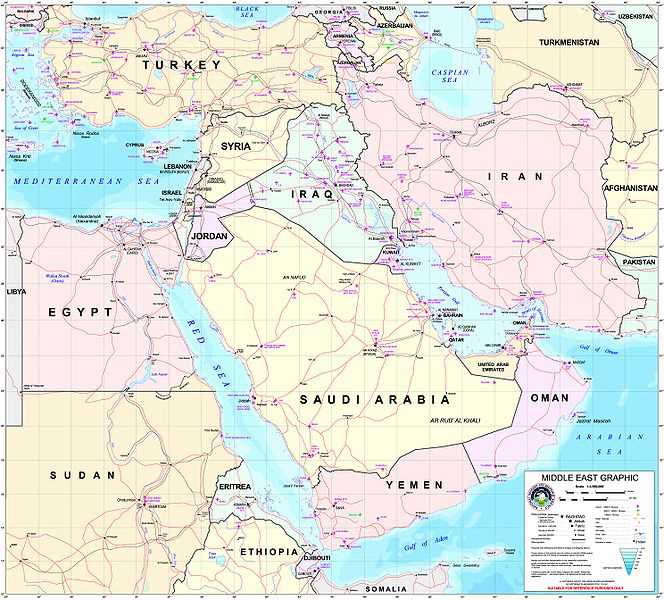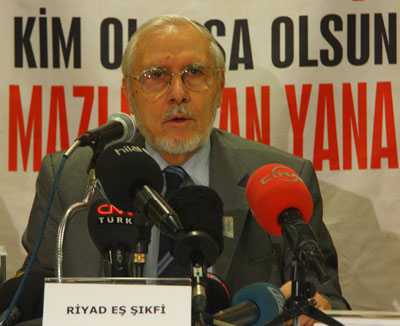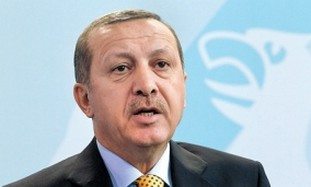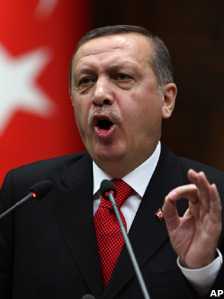By İsmail Duman, World Bulletin
“The Middle East region has been passing a legitimacy test, in a sense, with the wave of rebellion in the last months. Up until some weeks ago, Syria had been passing this test quite successfully.” says Oytun Orhan, ORSAM Middle East Researcher.
And today, Middle Eastern fire began to spread in Syrian streets… As Tony Badran, from Foreign Affairs, emphasizes, “Over the past few months, many commentators have maintained that the regime would remain sheltered from regional turmoil…Now, the story line has changed dramatically. Events in the southern city of Deraa have challenged the conventional wisdom about Syria’s stability. Protests began on March 18, after security forces detained 15 children for spraying anti-regime graffiti on walls there.” Actually, in these days, it is possible to see these rebellions almost all the cities of Syria.
On the other hand, Omer Taspinar, from Today’s Zaman, asks for us the question of “What is driving the demonstrations in Syria?”: “The answer is no different than in Tunisia, Egypt or Libya. The ruling bloc is a family that controls the armed forces, the intelligence services, the police and large chunks of the economy in order to maintain a repressive regime. There is considerable youth unemployment, poverty and boredom as well.”
In my opinion, we should add a new question to this equation: “What is the difference of Syrian crisis in terms of its regional implications?” Okay, we accept that there was no any expectation about Syria in terms of Middle Eastern fire; but today, we meet face to face with this reality. On the other hand, the hope of regional powers was about the continuation of Syrian regime in a peaceful environment. Because of this hope, the reactions of these countries, today, are different from their reactions in Egypt, Tunisia and, to some extent, Libya. Turkey and Iran are the primary in this picture. While Iran is against this crisis in Syria directly, Turkey supports Asad regime through slow and sure explanations. About this issue, “Erdogan walked on egg shells this week – expressing support for his Syrian counterpart, while at the same time advising him to take a democratic approach toward the protesters.” said Aviel Magnezi, Israeli commentator.
What is the function of Syria in the region?
Then, we, firstly, should focus on the importance of Syrian crisis in terms of its regional implications. “What’s been missing in much of the comment is Syria’s sense of vulnerability to attack. Its allies, Iran and Hezbollah, have faced Israeli attempts to demonize and destroy them. Repeated efforts have been made to disrupt the Tehran-Damascus-Hezbollah axis, seen by many as the main challenge to Israeli and American hegemony.” says Patrick Seale. In addition to this, he answers the question of “Is Syria different from its Arab counterparts in terms of the uprisings and the response? If yes, how so?” so:
“Syria’s nationalist stance—its support for Hezbollah and Hamas, its opposition to Israel and the US—is essentially what makes it different from Egypt, Tunisia, Yemen or Bahrain. This is a source of pride for many Syrians and has given the country some immunity from popular protest. But, as we have seen, it is wearing thin.
Unlike Egypt and Tunisia, which are more homogeneous societies, Syria is a mosaic of sects, similar to Lebanon if not quite so diverse. This makes for divisions in society, for different social habits, cultural norms and also different loyalties. Hence a permanent sense that the delicate balance could be overturned.”
On the other hand, he mentions concerns of Turkey and Iran about this crisis in his article entitled “Regional Implications of Syrian Crisis”:
“Together with its two principal allies, the Islamic Republic of Iran and the Lebanese Shi’a resistance movement Hezbollah, Syria is viewed with great hostility by Israel and its American ally. The Tehran-Damascus-Hezbollah axis – of which Syria is the lynchpin — has long been seen as the main obstacle to Israeli and American hegemony in the Levant.
With backing from Washington, Israel has sought to smash Hezbollah, notably by its 2006 invasion of Lebanon, and to detach Syria from Iran, a country Israel views as its most dangerous regional rival. Neither objective has so far been realized. But now that Syria has been weakened by internal problems, the viability of the entire axis is in danger.
….
Turkey is deeply concerned by the Syrian disturbances since Damascus has been the cornerstone of Turkey’s ambitious Arab policy. Turkish-Syrian relations have flourished in recent years as Turkish-Israeli relations have waned and grown cold. Prime Minister Recep Tayyip Erdogan and his hyper-active foreign minister, Ahmet Davutoglu, have actively sought to mediate local conflicts and bring much-needed stability to the region by forging close economic links.
….
On all these fronts — Iran, Iraq, Turkey, Lebanon, Palestine, Israel — Syria is a key player. Its distraction by internal problems reshuffles the regional cards, and adds to the general sense of insecurity and latent violence.”
Iran’s stance on the side of Asad/Syria…
According to Hassan Hanizadeh, Iranian columnist, “the US and Saudi Arabia’s objective is to overthrow the Syrian government, cut Tehran-Damascus-Beirut axis and eliminate the Islamic resistance from Lebanon’s military equations.” On the other hand, as Yusuf Fernandez says, “according to some US analysts, the fall or weakening of the Syrian regime would have a knock-on effect in Palestine and would serve to isolate Hamas in Gaza. Moreover, Iran would lose its main ally in the Arab world and the Middle East. They also think that the installation of a US puppet in Damascus would have as its corollary, the transformation of the Lebanon into an Israeli fiefdom.”
The comments of Iranian columnists are very parallel to Iran’s position on Syrian crisis. Because they point out “the unseen picture” in this crisis, Iran is accused of being indifferent to massacres of Syrian regime. Actually, this game is arranged by superpowers like America because this stance is not related only by Iran, but also Palestinian groups, whether Islamic or not, explained their supports for Syrian regime through the same concerns of Iran. Although this reality, superpowers want to use this picture in order to produce a new sectarian war between Muslim groups and unfortunately, today we see some reflections of this game.
On the other hand, Syrian President Bashar al-Asad has also used the same argument to legitimate his regime’s response to protesters. As Patrick Seale says, “two points in the speech stood out from what was a rambling performance. The first was that Syria was facing a dangerous conspiracy aimed at arousing sectarian strife, thus threatening the unity of the nation. He compared this conspiracy to the one Syria had faced in 2005 and which it had managed to defeat. This was an obvious reference to the attempt by some foreign powers, notably the United States and France, to exploit the assassination of the former Lebanese prime minister Rafiq Hariri to drive Syrian forces out of Lebanon and even bring down the regime.”
Within the framework of these thoughts, “Now that Syrian people are demonstrating to voice their legitimate demands, the US, Saudi Arabia, Jordan, former Syrian vice-president Abdul Halim Khaddam and the March 14 alliance led by Saad Hariri have planted their elements among Syrian people to distort the image of protesters and create a distance between people and the government.” said Hassan Hanizadeh he adds: “The propaganda work by the media for the anti-resistance front culminated when the US Wall Street Journal newspaper claimed that Iran’s security forces and elements affiliated with Hezbollah, alongside with Syrian government forces, are involved in repressing poplar protests in the country. This is aimed at making the ordinary Syrians pessimistic toward the Iranian government and Lebanon’s Islamic resistance through false media advertisement.”
Moreover, Yusuf Fernandez emphasizes the same “false media advertisement” through his examples:
“This destabilizing campaign is easily perceivable in US media. In a recent opinion article published in the Washington Post, well-known neoconservative ideologue, Elliot Abrams, who was also a key advisor on Mideast policy at the National Security Council (NSC) during the George W. Bush presidency, openly supported a “regime change” in Syria. After insulting Syrian President Bashar al Assad, whom he called “thug”, Abrams claimed that Syria would be the “next regime to fall” in the Middle East.
Using the sectarianism as his weapon of choice against Syria, Abrams claimed a new regime in Syria would be controlled by the Sunni majority. A Sunni-dominated Syrian government, he says, “would never have” close relations with Iran and Hezbollah, and Iran “will lose” its Arab ally and land access to Hezbollah.
Abrams was joined by a Wall Street Journal’s editorial page that urged Washington to support the opposition “in as many ways as possible.” “It is impossible to know who would succeed Assad if his minority Allawite regime fell, but it is hard to imagine many that would be worse for US interests,” the editorial claimed.
Republican Senator John McCain and Independent Senator Joe Lieberman, one of the most notorious Zionist warmongers in the US Congress, said that Obama’s effort to engage rather than shun Damascus had “little to show for it” and declared it was time to back opposition to Assad’s rule. Both of them said that Washington must “continue to speak out loudly and clearly” against Assad’s regime. Republican Senator Jon Kyl, a fierce critic of all efforts to engage Damascus, said Washington should demand Assad step down and called for US Ambassador in Syria, Robert Ford, to “investigate” Assad’s response to unrest. Kyl claimed that Syria opposed “to the vital national security interest of the United States,” citing its support for Hezbollah and Hamas.”
After looking at the Iran’s stance, we can say that Iran explains its support for Syria and Bashar Asad directly, not indirectly. After that, we want to look at the stance of Turkey because although it also supports Asad regime, Turkey is some worried about the developments in Syria because of some undemocratic practices. According to Alon Lieli, former Israeli ambassador to Turkey and Foreign Ministry director-general, Turkey will continue to support Syria unconditionally: “Despite all the casualties, I don’t see Erdogan abandoning Assad, or calling him to resign.”
But, I wonder whether his prediction will come true or not…
And Turkey’s stance…
“What does all this mean for Turkey?” asks Omer Taspinar and adds: “Ankara has had a love affair with Damascus under the Justice and Development Party (AKP) government over the last eight years. The Syrian-Turkish bilateral relationship is a remarkable story of a journey from enmity to best friendship. This puts a lot responsibility and pressure on Turkey’s shoulders. The events in Syria will provide a crucial litmus test for Prime Minister Recep Tayyip Erdogan in terms of testing his commitment to democratization in the region.”
“As one of Syria’s key allies, with a close political relationship and extensive economic ties, Ankara is much better placed to influence Syrian decision making, even though Damascus jealously guards its sovereignty over domestic policy.” says Phil Sands. “Mr. Erdogan is considered to be one of the world leaders closest to Mr. al Assad, an affinity that has led to a quick strengthening of their countries’ links. Turkey has supported Syrian foreign policies, including its combative stance towards Israel, something for which Damascus is chastised by the US and, to a lesser degree, the EU.”
In addition to these, “Can Turkey help defuse this potential conflict?” asks Fevzi Bilgin and also adds: “The recent friendly relations between Turkey and Syria may play a role. Syria is on uneasy terms with Iraq and Lebanon and technically at war with Israel. That leaves Turkey as Syria’s only window of opportunity in the region. In 2007, the two countries signed a free trade agreement and in 2009 they mutually lifted the visa requirement for short visits. In 2010, over 1 million Turkish citizens visited Syria while over half a million Syrian citizens visited Turkey. Northern Syrian city of Aleppo is swarmed by Turkish citizens and businessmen. There are now 27 weekly flights between Syria and various Turkish destinations. Thus, it would be quite imprudent for the Syrian government to squander this valuable relationship and opportunity for liberalization and, instead, choose to violently suppress demands of its own people while putting thousands of Turkish citizens in Syria at risk. Syria is too close to home, so if this ever happens Turkey cannot and would not stay quiet.”
In parallel to these comments, we witnessed the explanations of Turkish leaders for Syrian President Asad. According to the news of Sunday’s Zaman Newspaper, “Turkey, which has supported the demand in North African and Middle Eastern countries for democratic rights, is taking the side of the public and is trying to encourage Syrian President Bashar al-Assad to implement reforms.”
As Jacques N Couvas says, “Erdogan and Syrian President Bashar al-Assad had daily phone calls and Turkish Foreign Minister Ahmet Davutoglu followed up with a teleconference with his Syrian counterpart Wallid al-Mouellem to offer Turkey’s assistance in the event of a reform process towards a democratic regime.
The head of the Turkish National Intelligence (MIT), Hakan Fidan, was dispatched on Sunday to Damascus to express his government’s concerns about spreading social unrest from Daraa, in Syria’s southwest, to larger cities such as Latakia, a Mediterranean port nearer the Turkish border.”
“We advised Mr. Assad that responding to the people’s years-old demands positively, with a reformist approach, would help Syria overcome the problems more easily,” said Erdogan to the journalists. “I did not get a ‘no’ answer,”
On the other hand, as M K Bhadrakumar emphasizes, Turkish President Abdullah Gul used uncharacteristically strong language: “Whatever needs [to be done] should be done. There can be no closed regime on the Mediterranean coast. Assad is aware of this, too … We are sharing our experiences with him and we do not want chaos in Syria.” Gul’s adviser Ersat Hurmuzlu demanded: “Waiting for the protests to end to make reforms is a wrong approach. Necessary reforms should be made now, not later. Leaders should be brave … It would be an easy transformation if the Syrian administration can make significant reforms on human rights and democracy and find solutions in the struggle against corruption.”
What are the concerns of Turkey?
But when we look at the picture widely, although these reactions, it seems as if Turkey is very unwilling about regime change in Syria. For the reasons of Turkey, it is possible to mention the same reasons of Iran; but, on the other hand, there are some specific reasons for it.
“A major concern for Turkey is the Kurdish population in Syria of 1.4 million, which, in case of collapse of Assad’s regime could collude with the estimated 15 million or more ethnic Kurds in Turkey, 7 million Iranian Kurds, and 6 million Northern Iraqi Kurds to claim an independent state.” says Jacques N Couvas.
“The Turks are afraid of an uprising in Turkey, if Syrian Kurds decide to join in,” said Prof. Ofra Benjo, a senior research fellow at the Moshe Dayan Center and lecturer of Middle East history at Tel Aviv University. “For the past few months Kurdish uprisings have been taking place in eastern Turkey, but do not get broad media coverage. They are as severe as those taking place across the Arab world – you have youngsters and even children handling Molotov cocktails, stones and fireworks.
So far, the Turkish military has managed to divert the attention with swift suppression and a false claim according to which the riots are carried out only by PKK members… While the conflict between Turkey and the PKK cost the lives of tens of thousands of people, Erdogan’s treatment of the Kurds is more moderate than that of his predecessors,”
On the other hand, according to Sami Moubayed, from Atimes, Ahmad Barakat of the Syrian Kurdish Democratic Progressive Party spoke then to the Christian Science Monitor, saying, “Our problem is very different from that of the Kurds in Iraq. Their aim in Iraq is to get a state of their own. But in Syria, we just want our culture and freedom as Syrian nationals.”
As a different comment, Birol Akgün, the head of the international relations department at Selçuk University and a specialist working for the Institute of Strategic Thinking (SDE) says so: “Anything that happens in the four countries that have Kurdish populations will be of interest to Turkey. But to what extent Turkey will be affected by them depends on developments. Turkey will surely be affected if things really amount to chaos in Syria. But the impact on Turkey will be of a different nature. Western countries can be expected to meddle in Syria without hesitation as they did in Libya. This is because Syria is a key country for the security of Israel, which may be expected to facilitate the Western intervention with Syria. Already, it is being accused of inciting the incidents. Unlike in Libya, there is a sizable Christian population in Syria. However, if Syria speeds up its democratization efforts, the process will certainly be reversed. The real danger with Syria is not Kurds, but Western intervention. Syria is not capable of having any impact on Turkey in terms of the Kurdish issue. For these reasons, Turkey is trying to ensure a managed transition in Syria,”
“Turkey has abandoned its former rhetorical foreign policy. Erdogan’s visits to Arbil and Najaf are evidence that this old policy has been discontinued. If Turkey were still following its old foreign policy, then developments in Syria or another country in the region would have definitely affected Turkey. But the process of democratization, which was launched together with the new foreign policy, has made Turkey an exceptional country in the region.” says Associate Professor Veysel Ayhan from Abant İzzet Baysal University. “I have an optimistic, not a pessimistic, view about the developments in the region. Syria will be able to prevent problems from deepening by making reforms with the help of Turkey. Turkey will not be affected by the developments as long as Syria continues the reform process.”
In addition to Kurdish problem, according to Ofra Benjo, the special relationship is “not only about the affinity between two Muslim countries, but also about the private and public economic relations, which include a Turkish investment of some $1 billion in Syria, and many other investments in the political and social spheres, which might go down the drain,”
As a parallel comment, “The Turkish nervousness about the Syrian domestic situation is also influenced by economic and geopolitical concerns. After a long period of cold neighborhood relations, with occasional threats of armed confrontation, Assad and Erdogan have crossed the fence to develop a cosy relationship, building on the settlement in 1998 of old political disputes.” says M K Bhadrakumar.
Besides, we can mention “Shamgen (joint visa) Project”. Through this project, Turkey, Iran, Iraq and Syria have signed many agreements between them and actually this project is like an alternative to European Union. We can see this reality from the sentences of Turkish Prime Minister: “EU has Schengen. Why can’t we create something similar? Why is there fear and reluctance? It is impossible to understand this.” So, Turkey is unwilling to any regime change in Syria because of the fact that Asad and Erdogan are very good friends and cooperators.
In related to the concerns of Turkey, Göktürk Tüysüzoğlu, a research fellow in the international relations department at Giresun University, focuses on the same arguments of Iranian commentators. He noted that external factors play a great role in the rise of revolts in Syria and he added: “the US and Israel in particular have their hands in the insurgency in that country. The West wants to have a Syrian administration that officially recognizes Israel and would not pose a threat to Israel’s security… Turkey’s foreign policy has won the hearts of the Middle Eastern peoples and that Turkey will certainly respect the choices of the Syrian people.” “In the medium and long terms, Turkey will respect choices made by the Syrian people and cooperate with whatever administration is in office. By both lending conditional support to the Assad administration and urging it to implement reforms, Turkey is trying to avoid the destructive events seen in Libya,”
Prof. Ofra Benjo makes also the same prediction about Turkish foreign policy: “Erdogan will continue his balancing act; he will speak against violence and use of force and in favor of human rights, in an effort to portray himself as a supporter of such rights. He will present a moderate picture to the western world – to which he wants to belong – and continue to support Assad while seeing where the wind blow,”; but she also notes that his support hinges on future developments; if Assad increases the use of violence against civilians, “Erdogan will find it difficult to continue backing him and his oppressive regime amid efforts to join the European Union,” she noted.
Concluding comments…
Although as Tony Badran says, one Syria specialist, Joshua Landis, noted that unlike the aging Mubarak, the young Assad was “popular among young people” who “tend to blame [corruption] on . . . the ‘old guard.’”; it seems that today this picture has dramatically changed. Also although there is no serious protest in Damascus, in many Syrian cities, it is possible to come across the protesters who chant slogan as a “freedom, freedom, we want freedom”.
After this process, the main issue which is wondered is whether Asad regime will prefer to make reforms or not. Or else, will he prefer to continue his father’s oppression heritage? According to Omer Taspinar, “as all experts of the Middle East know, Syria is one of the most brutally repressive regimes in the Arab world. Assad’s father showed no mercy against the Muslim Brotherhood to protect his Baathist regime. It is estimated that Hafez Assad killed more than 20,000 people when he crushed the 1982 insurrection by the brotherhood in the city of Hama.”
Everyone fears that Asad will use a force in order to prevent these protests rather than preferring “reform way”. Tony Badran also talks about this issue very clear: “On March 24, U.S. Secretary of Defense Robert Gates urged that Syria follow Egypt’s example. However, as the protests spread throughout the rest of Syria, Assad will surely follow another example: Hafez al-Assad who set the precedent, in 1982, when he pulverized Hama, a Muslim Brotherhood rebellion city, killing nearly 20,000 to secure his rule. That legacy has kept the Syrians fearfully silent — until now. ”
In contrast to this pessimism, some Syrian columnists, such as Sami Moubayed, are very optimists about the reforming process. We hope that they will be true… But, for today’s picture, we see that there is oppression against people… On the other hand, this is indisputable fact that “efforts (of America) have been made to disrupt the Tehran-Damascus-Hezbollah axis”.
Here, the main question is that where will we stand in this picture? Before answering this question, firstly, I want to look at the stance of Hariri group and Israel.
In Wikileaks, we came across Hariri’s sentences about Syria and the Muslim Brotherhood Movement. In these leaks, “Saad urged that now is a golden opportunity for the international community to ‘weaken’ Bashar. The USG needs a clear, new policy to isolate Syria. ‘My belief is, if you don’t isolate Syria, if you don’t put a blockade, they will never change.’ By subduing Syria, you remove Iran’s main bridge for playing the troublemaker in Lebanon and Palestine. ‘If you weaken Syria,’ Saad suggested, “then Iran has to work alone.”
Saad suggested that the Syrian Muslim Brotherhood, in partnership with ex-regime figures like Abdel Halim Khaddam and Hikmet Shehabi (‘though he’s still close to the regime’), could step into the void. Saad claimed that the Syrian Brotherhood is similar in character to Turkey’s moderate Islamists. ‘They would accept a Christian or a woman as President. They accept civil government. It’s like Turkey in Syria. They even support peace with Israel.’ saying that he maintains close contact with Khaddam (in Paris) and Syrian Muslim Brotherhood leader-in-exile Ali Bayanuni (in London), Saad urged us to “talk to Bayanuni.”
On the other hand, about Israel’s position on Syria, “he (Saad) argued that nothing is really being done about Syria. Israel, he claims, protects Syria due to its fear of the unknown. ‘Better the enemy you know than the enemy you don’t know,’ is how Saad views the Israeli position on the Asad regime.”
Besides, Yusuf Fernandez, Iranian commentator, emphasizes almost the same point: “However, it is noteworthy to point out that other pro-Israeli analysts disagree with this view and fear that changing regimes in Egypt, Jordan and Syria could result in what Israeli media is calling a ‘Sunni ring,’ which would enhance the influence of the Muslim Brotherhood on developments in the region.”
After we look at the position of America-Suud (Hariri) and Israel, we can turn again to our question: “Where will we stand in this picture?”
Muslim world, today, is passing an important test. In my opinion, firstly, we should decide our priority list. What does ‘priority list’ mean? We know that today there is almost a massacre in Syria against people; but at the same time, Syrian crisis is triggered by superpowers like America and as a trend, they prefer to work with Islamic-rooted liberal governments rather than dictators in the Middle East. In this way, they aim to prevent Iran-Palestinian Resistance Movements and Hezbollah in this chess.
Of course we should call out to Syrian regime in order to make reforms for its people; but at the same time, we should decide that calling Western intervention for the good future of Syrian people will cause to irreparable wrongs in the distant future of the Middle East. So, it is not a true way to hope a help from America or any other country. We should not forget that “The Tehran-Damascus-Hezbollah axis – of which Syria is the lynchpin — has long been seen as the main obstacle to Israeli and American hegemony in the Levant.”
About the developments in Syria, “the possibility that the events in Syria could result in a change of regime or power is quite low.” says Oytun Orhan and he gives the list of reasons for us. I will summarize them here:
“1. The Iraq experience that was gone through after the 2003 invasion set a bad example to the Syrian people on what would be the consequences of the abolishment of a strong centralized authority.
2. The underlying reason of the legitimacy problem, which most of the Arabic governments have gone through, is the nature of the relations with the U.S. and Israel as well. And Syria is in a different situation compared to most of the Arab countries in this sense.
3. From the slogans in the demonstrations and the symbols which the reactions are directed to, it is understood that there is a general reaction against the government not individually against the Head of State Bashar Assad; in fact it is seen that he has a certain popularity.
4. One of the most important weaknesses of the demonstrations in Syria is the lack of an organized opposition movement, which could direct the movement having a demonstration tradition for years.
5. The fear that has got into the Syrian people is one of the handicaps on the way of the demonstrations for reaching the potential that could overthrow the regime.
6. Another factor that makes Syria different than Egypt and Tunisia is the structure of the army. In case the demonstrations get more expanded, it would be true to expect that the Syrian army will be on the side of the leader as a whole rather than Egypt and Tunisia.
7. The monopoly of the Ba’ath Party in the political field is considered as disturbing. However, on the other hand, the “Arab nationalist and secular” ideology of the regime is considered as a guarantee for the security and stability of the country by many groups.
8. One of the biggest weaknesses of the disorganized opposition movements is the fact that most probably the regional dynamics are in favor of status quo rather than change in Syria. In case the demonstrations reach a level that could threaten the regime, it is probable that the Bashar Assad administration would take France on its side too, as well as the regional powers such as Turkey and Iran.”
Today, it seems that some of these reasons are/will be inactive. Maybe, it is possible to come across “a new Libya” in Syria in a near future. Although we do not want a new Libya in the region, we can draw this picture in the light of many American commentators. In my opinion, America can/will prefer the same way for Syria despite Israel’s opposition because many American theorists know that today many Islamic liberal movements are not obstacle for America’s “Greater Middle East Project”.
Because of this reality, we should be very careful…
And also we want to call out to Turkey’s AKP Government from here again… Today, they are continuing balancing act in this issue. And, I think they also, very well, know “the efforts which are made to disrupt the Tehran-Damascus-Hezbollah axis”; and everyone knows that what it means for Turkey… But, if Syria will be a new Libya, what will become Turkey’s position? This is very critical question.
Turkey “walks on egg shells” again… If it will not be careful, many plans about the region can go to waste and also, the future of Muslim World can get into danger…


 Mr Erdogan, much like the Syrian public, appears to have expected these measures would be introduced by Mr al Assad in his speech last Wednesday, the Syrian leader’s first public response to anti-government demonstrations.
Mr Erdogan, much like the Syrian public, appears to have expected these measures would be introduced by Mr al Assad in his speech last Wednesday, the Syrian leader’s first public response to anti-government demonstrations.
 “Beyond governmental change, there were expectations on removal of emergency rule, release of political prisoners and a new constitution,” Erdogan told journalists who accompanied him on Friday on his way back from an official visit to London.
“Beyond governmental change, there were expectations on removal of emergency rule, release of political prisoners and a new constitution,” Erdogan told journalists who accompanied him on Friday on his way back from an official visit to London.
 I’m
I’m 